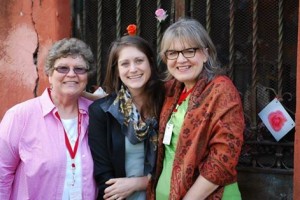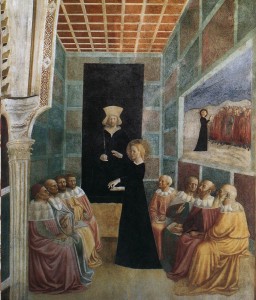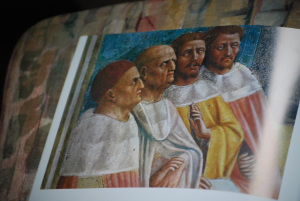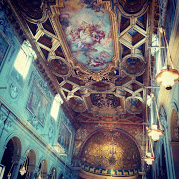To those who see… the FutureChurch

Sr. Chris Schenk, Kate Conmy, and Therese Korturbosh at the Shrine of Pope Joan (photo credit: Deb Rose-Milavec)
Guided by Dr. Carolyn Osiek and Sr. Christine Scheck, executive director emerita of FutureChurch, a pilgrimage of about 20 people traveled to Rome to experience and study the archeological sites of women “officeholders” in the early Church. On our first night of introductions together, it was obvious that the room could start a small faculty: doctors, theologians, lawyers, professors, priests (and those called to the priesthood), and at least one masters degree for everyone in the room. Many of us were excited to meet Ann Graham Brock author of Mary Magdalene, the First Apostle: the Struggle for Authority. As an aside, it felt so good to be in this good company: after two months in Rome and witnessing the priestly recoil upon mentioning my work, the FutureChurch pilgrims applauded when I introduced myself.
On Saturday, we traveled the San Clemente Basilica , a church of truly layered history, and incidentally, just cross the street from the Shrine to Pope Joan. Archaeologically speaking, the structure shows how 1st century Roman religion became a 4th century Christian church and finally a 12th century basilica. While on the tour, Dr. Ann Brock pointed out that while a fresco to on the side of the basilica shows St. Catherine teaching, the guide book shows only the male philosophers with St. Catherine completely cut out. Sometimes I am still surprised at the tedious lengths of institutional sexism our Church not only sanctions, but celebrates. Thanks to Deb Rose-Milavec for the photos:

Now you see St. Catherine

Now you don’t.
Even on Sunday, during a homily on the Woman at the Well — one of the longest theological gospels we have between Jesus and anyone, a well-intentioned priest failed to mention gender. At all. His homily drew a parallel between the water of the well and the cross, and basically talked a lot about Pilate (ironically how he takes up so much of our Holy Week, while we’re waiting for Easter). It is not only the historic invisibility of women in our Church’s (mainstream) history, but our continued culture of blindness that is (perhaps naively), still incredulous to me. I waited, for this nice priest to say something about the woman Samaritan, something about Jesus speaking to this woman, but I waited for nothing.

Basilica of San Clemente
Although, what I didn’t have to wait for was Regina Bannon, former WOC Board Member and SEPA-WOC coordinator to confront this priest and offer some feminist hermeneutics suggestions on how he might develop his homily, maybe draw some parallels to the resurrection, for next time. Bless. Bless. Bless. While I was still holding my song book and wiping the words, “you might be the patriarchy” from my thoughts, Regina had already tended to the situation. After Mass, standing around swapping Elisabeth Schüssler Fiorenza quotes, I had that feeling again: it is good to be in this good company.
Thank you FutureChurch pilgrims!

One Response
The wonderful young Filipino priest at st Patrick’s cathedral in Auckland NZ spoke of Christ’s desire to rehabilitate women in his encounter with the woman at the well, comparing her to Eve. Christ was clearly challenging traditions relating to women. I was encouraged that this was even raised.